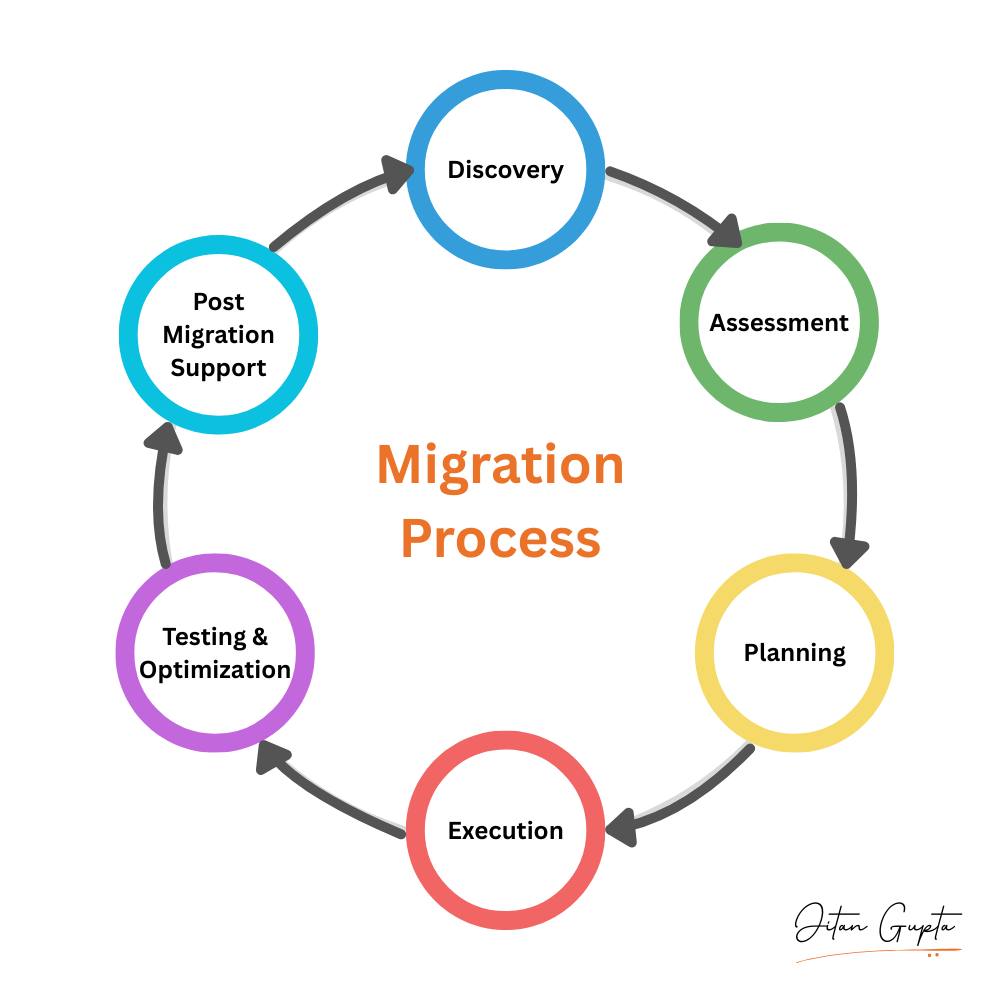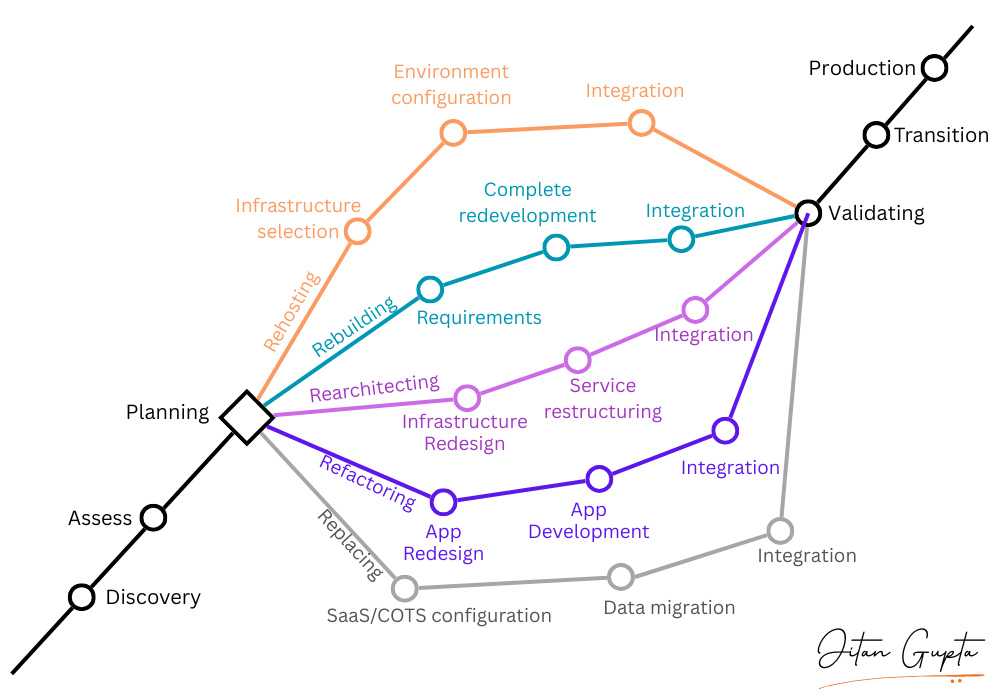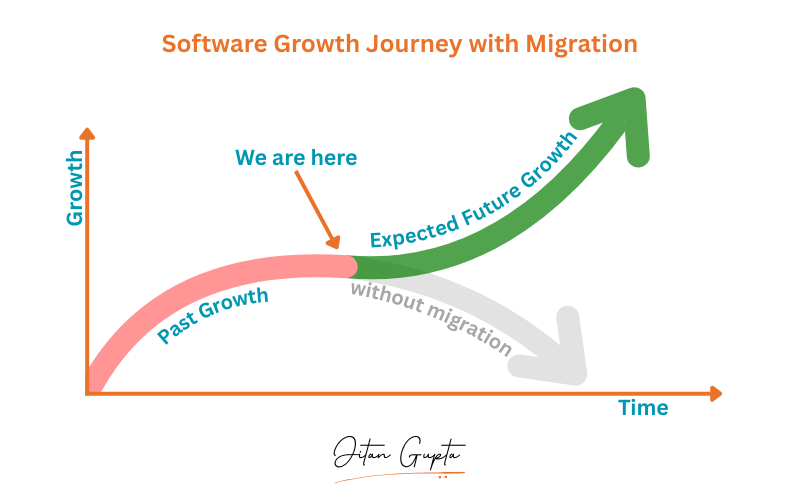The Cost of Doing Nothing: Why Migration Matters
Your legacy software isn't outdated—it's costing you time, money, and growth.
🚨 Common Pain Points:
- High maintenance costs and tech debt.
- Security vulnerabilities and compliance risks.
- Poor scalability and slow performance.
- Integration roadblocks with modern tools.
- Difficulty in attracting top engineering talent.
💡 The Opportunity:
A smooth migration can lower costs, reduce risks, and protect your business's future. Plus, it will not disrupt your daily operations.
Next: Here’s how we make migration seamless.
Migration Approach
Successful migrations are more than just technical tasks. They need a clear plan. It should limit disruptions, meet regulations, and allow for future growth.

My six-phase approach has evolved through various migrations across industries and tech environments:
1️⃣ Discovery → Uncover dependencies and potential blockers upfront.
2️⃣ Assessment → Evaluate risks, compliance and business impact.
3️⃣ Planning → Define scope, migration strategy and testing plan
4️⃣ Execution → Data migration, system integration, phased rollout.
5️⃣ Testing & Optimization → Validate performance, security and reliability to prevent post-migration failures.
6️⃣ Post-Migration Support → Ensure long-term stability with continuous monitoring.
This method works in many industries. It guarantees a smooth and reliable migration each time.
Migration Strategies
Strategic Approaches for Optimal Results

The right strategy depends on system complexity, business goals, and risk appetite. Here's how to decide:
| Strategy | Best For | Key Benefit | Risk Factor |
|---|---|---|---|
| Rehosting (Lift & Shift) | Fast migrations, minimal changes | Quickest time to value | May carry over legacy issues |
| Refactoring | Modernizing apps for cloud-native benefits | Improves scalability | Higher effort, longer timeline |
| Replatforming | Moving to a new runtime with minor tweaks | Balances speed & flexibility | Some dependency risks |
| Rebuilding | Full re-engineering of the system | Future-proofing & performance | High effort & cost |
| Retiring | Phasing out outdated apps | Cost savings | Data archival challenges |
🔍 Not sure which strategy fits? Let’s discuss this in a free 1:1 call!
Risk Management
Proactive Mitigation for Seamless Transitions
Legacy migrations come with risks. You can manage these challenges if you identify, assess, and mitigate them properly. They won't threaten your project. Our framework uses lessons from many successful migrations in different industries.
Gartner reports that 83% of software data migrations fail or go over budget and schedule. A study by McKinsey and Oxford shows that large IT projects often go over budget and take longer than planned. On average, they exceed budgets by 45% and timelines by 7%. Additionally, these projects deliver 56% less value than expected.
| Risk Category | Common Issues | Mitigation Plan |
|---|---|---|
| Technical Risks | Data loss, downtime, API integration challenges | Pre-migration backups, phased rollouts, and rollback capabilities |
| Business Risks | Unexpected costs, scope creep | Fixed-cost contracts, clear scope definitions, early budget planning |
| Security Risks | Compliance gaps, data breaches | Encryption, role-based access controls, secure CI/CD pipelines |
| Operational Risks | User resistance, training gaps | Early stakeholder buy-in, structured training programs |
My Risk Mitigation Approach
-
🔍 Pre-Migration Safeguards
- Conduct risk assessment workshops with key stakeholders.
- Evaluate database backups & rollback mechanisms.
- Set up a sandbox environment for testing before migration.
-
🚀 During Migration Controls
- Implement phased rollouts instead of a big-bang migration.
- Use automated monitoring tools to catch early failures.
- Have a disaster recovery plan (DRP) in place.
-
📊 Post-Migration Stabilization
- Run performance benchmarking tests.
- Provide dedicated hypercare support for 4-6 weeks.
- Collect feedback from users & iterate.
Risk Management in Action
For each project, I develop a customized risk register that:
1️⃣ Impact Analysis: Assess risks and dependencies before migration.
2️⃣ Pre-Testing: Validate critical features in a staging environment.
3️⃣ Phased Rollout: Start with non-critical systems before full deployment.
4️⃣ Real-Time Monitoring: Set up dashboards to track system health.
5️⃣ Rollback Strategy: Implement immediate recovery plans if needed.
6️⃣ Post-Mortem Review: Document learnings to refine future migrations.
FAQ
Common Questions About Legacy Migration
Depends on system complexity—small migrations: 3-6 months, enterprise-level: 12-24 months. I provide a detailed timeline after the assessment.
Depends on system complexity—small migrations: 3-6 months, enterprise-level: 12-24 months. I provide a detailed timeline after the assessment.
Costs vary based on scope & strategy. I provide phased estimates after assessment.
Costs vary based on scope & strategy. I provide phased estimates after assessment.
I use phased rollouts, parallel systems & off-hours implementation to minimize downtime.
I use phased rollouts, parallel systems & off-hours implementation to minimize downtime.
Yes! Incremental migration ensures a smooth transition without disrupting existing workflows.
Yes! Incremental migration ensures a smooth transition without disrupting existing workflows.
I use multi-layered validation: pre-migration checks, transformation testing, and post-migration reconciliation.
I use multi-layered validation: pre-migration checks, transformation testing, and post-migration reconciliation.
Early stakeholder involvement, training, and ongoing support ensure smooth adoption.
Early stakeholder involvement, training, and ongoing support ensure smooth adoption.
I provide post-migration support + optional long-term maintenance.
I provide post-migration support + optional long-term maintenance.
System documentation (if available), architecture diagrams, key pain points & business goals.
System documentation (if available), architecture diagrams, key pain points & business goals.
Yes! Proof-of-concept projects validate strategy before full migration.
Yes! Proof-of-concept projects validate strategy before full migration.
